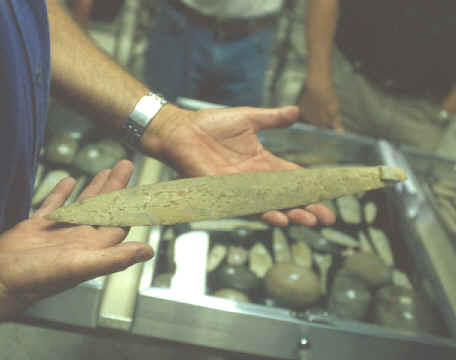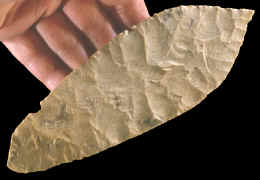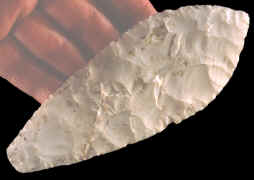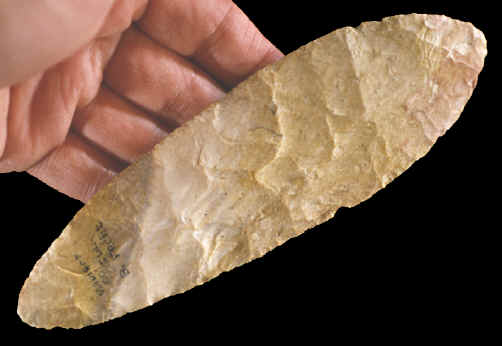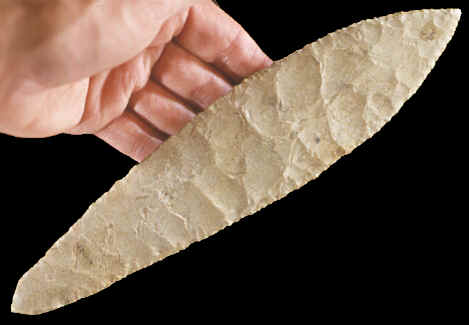|
|
|
Most Ramey knives are under 9 inches in length, but a few have been found that are much longer. The longer examples are often times referred to as swords, even though they were probably never used as weapons. These longer bifaces are believed to have been used as dance swords. Evidence for this comes from Etowah & Spiro shell engravings on gorgets and dippers. Individuals are shown holding these long "swords" as they appear to be dancing. |
|
|
|
|
The Aztec empire left behind several examples of "personified bifaces" in the form of stone knives and written documents that illustrate them. These knives were painted and decorated with Obsidian & shell to form eyes and teeth. They represent a day in the ritual calendar and one of the Aztec gods. Some of them look very similar to Ramey knives, less the decoration. It would be almost impossible to prove a god image connection to a Ramey knife. But a recent paper by Mary Vermillion describes two Ramey knives that were painted red and green with copper and red ochre. They were found near Cahokia in the wall trench of a Mississippian house. Large painted chert bifaces & carved and decorated wood bifaces were also found in Craig mound at Spiro. Painted Ramey knives suggest there may be a connection to some type of mythological concept. |
|
|
|
|
A few Ramey knives do show extensive use wear. Some of their edges are polished from use. So it's obvious that a certain percentage of them were being used for cutting. Many of them probably also had handles. They could have been hafted onto finely carved handles made of bone or wood or they may have used a simple leather wrapping for a handle. |
|
|
|
|
At first impression, Ramey knives do appear to be just knives. But evidence shows they were being used in several different ways that fall into both utilitarian and ceremonial categories. They appear to be multi-purpose tools. A comparison might be made to exchange stones that were used in New Guinea for hundreds of years. Without a living culture and their oral history, it would not be possible to know how these polished stones were used. In addition to their utilitarian use as items of value for trade they were also used in funeral ceremonies where a group of them laid out together represented a human being. Also, certain exchange stones could be selected and given special powers to hold a human spirit. It's interesting to note that it's reported that any paint on an exchange stone is evidence that it may have a ceremonial connection. So like exchange stones, current evidence shows that Ramey knives probably did have several different applications, both utilitarian and ceremonial. |
|
|
The best of the Ramey knives represent the finest craftsmanship the Cahokia flintknappers produced. They must have been important tools because so many were used as funerary offerings and in other ceremonies such as dance swords. We'll never know the complete story, but mysteries can be a good thing, especially around camp fires. |
|
|
"REFERENCES"
1912,
Hodge, Frederick Webb, "Handbook of American Indians, North
of Mexico," p. 717. |
|

